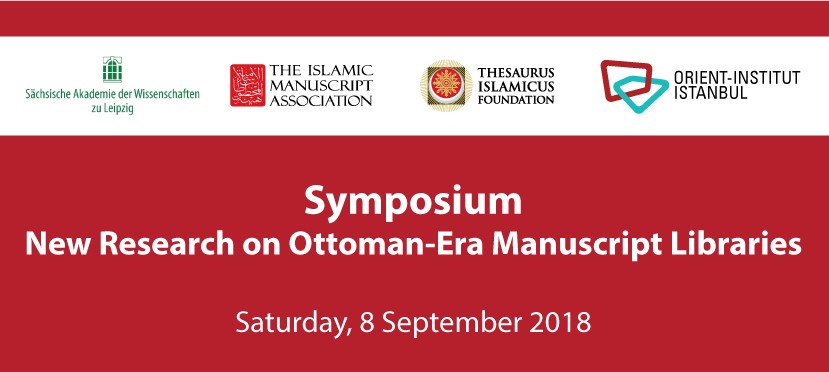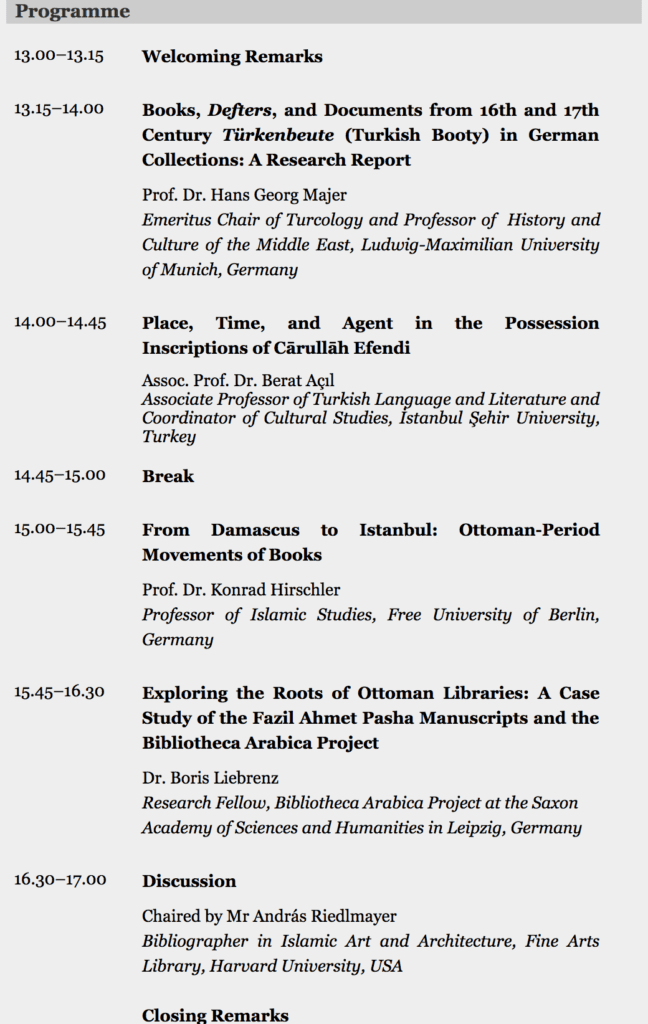September, 2018
08sep13:00New Research on Ottoman-Era ManuscrIpt LIbrarIes
Details
Abstracts Books, Defters, and Documents from 16th and 17th Century Türkenbeute (Turkish Booty) in German Collections: A Research
Details


Abstracts
Books, Defters, and Documents from 16th and 17th Century Türkenbeute (Turkish Booty) in German Collections: A Research Report
Prof. Dr. Hans Georg Majer
Emeritus Chair of Turcology and Professor of History and Culture of the Middle East, Ludwig-Maximilian University of Munich, Germany
Considerable booty was made on both sides in the wars between Sultan and Emperor throughout the 16th and 17th centuries. It consisted of cannons, ammunition, foodstuffs, and money, but also of weapons that were not rarely quite splendid, or of gear for man and horse, such as can still be seen today in the Türkenbeute department of the Badisches Landesmuseum in Karlsruhe. Additionally, looters took books, defters, documents, and letters. Yet, these are not concentrated in one single institution, but scattered across Germany in the collections of federal, communal, and private archives, libraries, and museums. Why this is so is a primary question. These rich holdings, themselves, can often answer questions such as ‚Where and when was the item taken (in an abandoned camp or a city)?‘; ‚Who took it?‘; ‚Did he keep it and why?‘; ‚Did he pass it on and to whom?‘; ‚Of what kind were the looted books (author, scribe, dates, origin)?‘; ‚Do the looted defters and documents point to official or personal owners?‘; ‚What can we learn from them about the Ottoman bureaucracy, the army and its personnel, and the latter’s relationship with the written word?‘; and ‚How can we even distinguish booty from holdings of a different provenance?‘.
Place, Time, and Agent in the Possession Inscriptions of Cārullāh Efendi
Assoc. Prof. Dr. Berat Açıl
Associate Professor of Turkish Language and Literature and Coordinator of Cultural Studies, İstanbul Şehir University, Turkey
Being one of the most significant scholars, bibliophiles, librarians, and judges in the Ottoman Empire, Cārullāh Efendi (d. 1738) and his library—which is located under his name as a collection within the Süleymaniye Manuscript Library—provide new perspectives on book culture studies. There are 2,181 manuscripts in the collection, and 1,094 of these contain both personal records and the date of purchase or acquisition whereas just 51 one of them provide information pertaining to the place of purchase or acquisition. To put it another way, most of the manuscripts contain possession inscriptions with information about when and where they were bought or obtained as well as personal records about Cārullāh Efendi. This talk will examine these inscriptions according to the places, times, and agents they express. It will show that by analyzing possession inscriptions one can understand how the collection has been established, from where the manuscripts came, and how Cārullāh Efendi has defined himself over time, enabling us to trace his self-perception.
From Damascus to Istanbul: Ottoman-Period Movements of Books
Prof. Dr. Konrad Hirschler
Professor of Islamic Studies, Free University of Berlin, Germany
This paper discusses the movements of manuscripts in the Ottoman period taking the case study of Damascus and Istanbul. It focuses on three collections of manuscripts, the Ashrafiya Library, the Umariya Library and the Qubbat al-Khazna corpus. These Damascene collections were built up, mostly in the Mamluk period, in very different institutional contexts. Their Ottoman-period trajectory also differs widely, but manuscripts from all three collections made their way to the cultural and political centre, Istanbul. Comparing these three cases gives insights into the logic of dispersal and reconfiguration of manuscript collections.
Exploring the Roots of Ottoman Libraries: A Case Study of the Fazil Ahmet Pasha Manuscripts and the Bibliotheca Arabica Project
Dr. Boris Liebrenz
Research Fellow, Bibliotheca Arabica Project at the Saxon Academy of Sciences and Humanities in Leipzig, Germany
The establishment of Istanbul’s many splendid libraries during the Ottoman period is a contentious issue. While they are recognized as outstanding institutions of learning and reading, they are also occasionally confronted with accusations of theft. To tackle this question in a nuanced manner, a turn to the manuscripts and a thorough research of their provenance is a prerequisite. Because Istanbul became the world’s largest repository of Islamic manuscripts, with books coming from all over the vast Ottoman realm and beyond, the analysis of central Ottoman libraries will throw light not only on the book culture of the Ottoman capital, it will also be an indispensable source for our understanding of the dynamics of manuscript production and libraries in the Arabic provinces as well. This talk will use the Fazil Ahmet Pasha collection to demonstrate what one can achieve with the systematic collection of manuscript notes. It will also highlight the methodology of the recently inaugurated Bibliotheca Arabica project, which will rely heavily on manuscript notes to chart a detailed map for the production and reception of Arabic literature in the manuscript age.
Zeit
(Saturday) 13:00
Ort
Orient-Institut Istanbul
Susam Sokak No:16 Kat:3 Daire: 7 Cihangir - İstanbul
